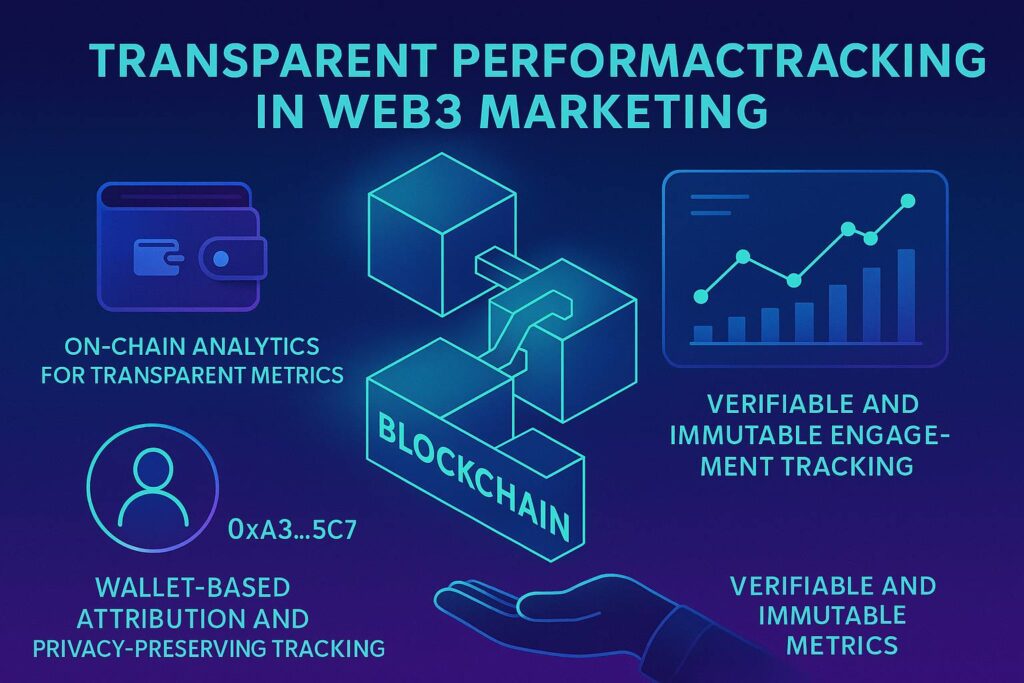For years, marketing agencies have operated behind a curtain—clients left to trust whatever glossy reports or vague KPIs landed in their inboxes. But that model doesn’t hold up in the Web3 space, where transparency isn’t just expected, it’s built into the tech.
With smart contracts, public ledgers, and on-chain data, Web3 flips the script, offering a radically transparent way to track performance, prove ROI, and align agency-client relationships with verifiable outcomes.
No fluff. No hiding. Just results that anyone can see.
In this article, we’ll explore how transparency is becoming the new gold standard in Web3 marketing, showing how campaigns across DeFi, NFTs, DAOs, and GameFi drive results with on-chain accountability and community-approved KPIs.
Changing Client-Agency Relationships in Web3
Web3 is redefining the dynamics between marketing agencies and their clients through blockchain’s trust mechanisms and community involvement. Three major shifts are occurring in these relationships:
Smart Contracts for Accountability and Trust
The relationship between marketing agencies and their clients has always been asymmetric. Agencies know a lot more about what they’re doing than clients do. This information asymmetry leads to distrust. Clients wonder if they’re really getting what they paid for and agencies spend a lot of time trying to prove their worth.
Smart contracts are changing this dynamic.A smart contract is basically code that runs on a blockchain and automatically enforces agreements – for example, releasing payment only when specific project deliverables or KPIs are met.
This ensures accountability: if an agency promises 100,000 impressions or a certain user growth, the funds (often held in escrow on-chain) won’t unlock until the blockchain data confirms those results.
This trustless enforcement minimizes disputes and builds confidence that both parties will uphold their end of the bargain.
Additionally, smart contracts can automate reward distribution or affiliate payments in real-time as project goals are achieved, reducing the need for manual reporting and verification.
Decentralized Governance and Community Input
Another shift is the rise of decentralized governance in marketing decisions.
In traditional settings, go-to marketing strategies are decided by a brand and its agency. In Web3, however, projects often have decentralized autonomous organizations (DAOs) or community governance where token holders vote on initiatives.
This means the “client” might not be a single entity but a community. Marketing agencies in Web3 may operate under DAO proposals and mandates, aligning their work with community-approved project objectives.
For example, the Dash cryptocurrency’s DAO allows masternode holders to vote on which marketing campaigns to fund, effectively letting the community decide what message to convey.
Such democratic decision-making makes the process transparent as proposals, budgets, and outcomes are visible on-chain or on public forums.
Community-Driven KPIs and Transparent Goals
With community involvement comes a change in which key performance indicators (KPIs) matter. Rather than solely focusing on traditional marketing metrics (like impressions, clicks, or sales), Web3 marketing places weight on community-driven KPIs that are transparently trackable on-chain.
These include metrics such as the number of token holders gained, participation in governance votes, growth of a Discord/Telegram community, or on-chain engagement (e.g. smart contract interactions like staking or NFT minting).
Because the blockchain makes these metrics public, the entire community can track progress, not just the client and agency. This transparency holds Web3 marketing agencies (or internal marketing teams) accountable to the community for hitting targets.
For instance, a DAO-run marketing initiative might set a goal to increase active wallet users by 20% in a quarter; the progress is continuously visible via blockchain explorers or dashboards. If targets are missed, it’s apparent to all stakeholders, prompting open discussion or governance action.
On the flip side, hitting a KPI can automatically trigger on-chain rewards (for the Web3 PR agency or for community contributors) through pre-defined smart contract logic.
Transparent Performance Tracking in Web3 Marketing
The biggest change Web3 brings to marketing is in performance tracking and analytics. Instead of relying on black-box ad network data or third-party analytics that can be fragmented or proprietary, Web3 marketing leverages on-chain data that is transparent and verifiable by anyone. This leads to new methods of tracking campaign performance:
On-Chain Analytics for Transparent Metrics
In Web3, nearly every user action such as buying a digital token, transferring an asset, voting in a DAO, or claiming an airdrop, is recorded on a public blockchain ledger. This rich on-chain data is transforming how marketers measure success.
Instead of waiting for a monthly report, marketers can query blockchain data in real time to see how a campaign is performing.
For example, if a marketing campaign is meant to drive sign-ups for a decentralized application, one can track the increase in new wallet addresses interacting with that dApp’s smart contract, visible on a blockchain explorer.
These metrics are not just internally available; they are transparent to all stakeholders.
Wallet-Based Attribution and Privacy-Preserving Tracking
Web3 introduces wallet-based attribution as a new way of tracking user journeys. A “digital wallet” (cryptocurrency address) is essentially a user’s identity in Web3.
Marketers can follow how a given wallet interacts with their product or campaign over time, building a rich engagement profile, all without knowing the user’s real-world identity.
For example, suppose a campaign distributes a special NFT coupon to users’ wallets; by tracking which of those wallet addresses later redeem the coupon in a smart contract or make a purchase, the marketer gets a clear conversion funnel from impression to action.
This is analogous to cookie-based tracking in Web2, but it’s more privacy-friendly and transparent as the user’s public wallet activity is voluntarily visible, and there’s no need to collect personal data like emails or names to attribute actions.
For instance, Adidas found value in issuing a POAP (an NFT badge) for a marketing event that allowed loyal fans to prove their participation and gave Adidas a list of wallet addresses deeply engaged with the brand.
Later, Adidas could airdrop exclusive offers to those same wallets, effectively attributing and re-targeting based on wallet activity without ever breaching user privacy.
Verifiable and Immutable Engagement Metrics
In Web3 marketing, data integrity is guaranteed by the blockchain. This means that key metrics used to evaluate campaign success are verifiable by anyone and tamper-proof.
For example, if a campaign’s deliverable is “increase the token’s holders by 5,000 this month,” the actual number of holders can be independently verified on-chain (e.g., by querying the token contract for unique holder addresses) and cannot be falsified by an agency.
Likewise, metrics like website visits or clicks (which in Web2 are tracked by private databases) are being supplemented or replaced by on-chain engagement metrics such as number of smart contract calls, volume of tokens transacted, or NFTs minted.
These are recorded on the blockchain’s ledger, providing an audit trail for digital marketing efforts and performance. One practical outcome is the rise of community dashboards where both clients and communities monitor these metrics in real time.
Since the data source is open, discrepancies or signs of fake activity (like bot-driven transactions) are harder to hide. Web3 marketers are thus incentivized to focus on genuine, quality engagement because superficial metrics would be evident on-chain.

Case Studies: Transparency in Web3 Digital Marketing Strategies
To illustrate how these principles play out, here are several real-world examples where Web3 has enabled transparency in project deliverables:
Brave Browser and BAT: Direct Advertiser-User Connection

Brave is a blockchain-enabled web browser that pays users in Basic Attention Tokens (BAT) for viewing ads, while advertisers purchase ad space with BAT, and a portion of that spend goes directly to the user.
This flips the traditional digital advertising relationship into a more transparent, three-way value exchange. Instead of relying on opaque ad networks and user-tracking without consent, Brave uses smart contracts and a built-in crypto wallet to reward attention.
The process is entirely opt-in and fully transparent in terms of reward distribution as users can see exactly how much BAT they’ve earned, and advertisers know their budgets go to engaged users rather than disappearing into a black box of middlemen.For marketers (advertisers), this means key deliverables like “user attention minutes” are guaranteed and accounted for on-chain.
They can verify how many tokens were distributed relative to their campaign, ensuring they only pay for actual views. For users, the transparency builds trust as they know what data (limited, anonymized behavioral data) is being used and can verify the token payouts they receive.
Dash DAO’s Community-Led Marketing Fund

Dash (cryptocurrency project), is often cited for pioneering a decentralized approach to funding and executing marketing via its DAO treasury.
Dash allocates a portion of each block reward to a community-governed treasury, and masternode holders vote on proposals to spend those funds on various initiatives many of which are marketing campaigns (exchange listings, sponsorships, meetup events, integrations, etc.).
This is a case where project deliverables are proposed, approved, and tracked by the community. This approach has inspired other crypto projects (e.g., Zcash, Decred, and even protocol-like Marketing DAOs on NEAR) to adopt treasury-funded marketing with community
Socios Fan Tokens (PSG & Others) – Transparent Fan Engagement

Socios is a platform that partners with sports teams to issue fan tokens, giving supporters a voice in club decisions. For example, Paris Saint-Germain’s $PSG token lets fans vote on minor club decisions (like choosing the design of a match day pennant) and unlocks VIP experiences.
These tokens are bought and traded on a blockchain (Chiliz), ensuring authenticity and a public record of ownership. Every fan vote and token transaction is recorded on-chain, meaning the community can see poll results and verify that only token holders influenced the outcome.
The token’s smart contract makes reward distribution (like raffle winnings or merch access) automated and tamper-proof. Fans even see the club using token revenue for buybacks, underscoring an open commitment to token value.
For Web3 marketing, fan tokens turn passive fans into active contributors. By openly showing how fan input shapes club activities, teams increase engagement and loyalty.
Adidas “Into the Metaverse” – NFT Loyalty Program with Visible Rewards:
Adidas launched Into the Metaverse, an NFT-based loyalty campaign, to integrate customers into its metaverse journey. The project began with 30,000 NFT passes minted on Ethereum, created in collaboration with notable NFT figures (Bored Ape Yacht Club, gmoney, PUNKS Comic).
Holders of these NFTs become part of an exclusive club unlocking both digital and physical perks. For instance, owners gained access to limited-edition merchandise (like co-branded hoodies and sneakers) and virtual land experiences.
Over time, Adidas evolved the campaign into multiple phases (Phase 1, Phase 2, and now ALTS by Adidas), where NFT holders could burn or upgrade their tokens to receive new benefits (such as unique avatar NFTs after Chapter 3).
By using NFTs and smart contracts, Adidas ensured that every reward distribution was trackable and fair. The scarcity of each drop was public and fans could see the exact supply and transactions on-chain during the mint, preventing any behind-the-scenes allocation.
Ownership of an Adidas NFT is verifiable on the blockchain, so only legitimate holders can claim the exclusive merchandise, eliminating fraud. On-chain data also lets Adidas and the community monitor engagement: e.g. how many holders redeemed physical products or participated in each chapter.
Transparency in Digital Marketing and Web3
Web3 is ushering in an era of transparency in marketing deliverables. From immutable proof of performance to community-governed campaigns and tokenized rewards, every facet of marketing is becoming more open and verifiable.
This transparency not only builds trust between clients and agencies (or projects and communities) but also aligns everyone’s incentives around clear, shared data. As these trends continue to develop, we can expect the broader marketing industry to adopt some of these Web3 practices, moving towards a future where marketing outcomes are as transparent as the blockchain itself.
To find out more, contact a member of our specialist team today.
